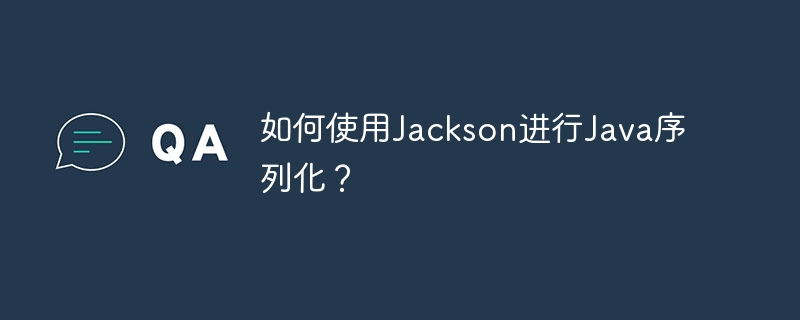How to use Jackson for Java serialization?
使用Jackson进行Java序列化可以分为以下步骤:添加Jackson依赖项:com.fasterxml.jackson.core:jackson-databind。创建POJO对象:定义一个包含与JSON结构对应的getter和setter方法的Java对象。创建ObjectMapper对象:实例化ObjectMapper,负责序列化和反序列化。序列化对象:使用ObjectMapper将对象序列化为JSON。实战示例:使用JDBC查询数据库并将其结果序列化为JSON。反序列化对象:使用ObjectMapper从JSON字符串反序列化对象。

如何使用Jackson进行Java序列化
简介
Jackson是一个用于Java对象的JSON序列化和反序列化的流行库。本文将指导您如何使用Jackson在Java应用程序中进行序列化。
添加Jackson依赖项
在您的Maven或Gradle项目中添加以下依赖项:
<dependency>
<groupId>com.fasterxml.jackson.core</groupId>
<artifactId>jackson-databind</artifactId>
<version>2.13.4</version>
</dependency>创建POJO对象
定义要序列化的POJO(普通旧Java对象)类,该类包含与JSON结构对应的getter和setter方法。例如:
public class User {
private String name;
private int age;
// 省略getter和setter方法
}创建ObjectMapper对象
Jackson的关键组件是ObjectMapper,它负责序列化和反序列化。创建ObjectMapper实例:
ObjectMapper mapper = new ObjectMapper();
序列化对象
使用ObjectMapper将对象序列化为JSON:
User user = new User();
user.setName("John Doe");
user.setAge(30);
String json = mapper.writeValueAsString(user);
System.out.println(json); // 输出:{"name":"John Doe","age":30}实战示例
假设您有存储用户数据的数据库表。您可以编写以下代码来查询用户并将其序列化为JSON:
try (Connection conn = DriverManager.getConnection(DB_URL, USER, PASSWORD)) {
Statement stmt = conn.createStatement();
String sql = "SELECT * FROM users";
ResultSet rs = stmt.executeQuery(sql);
List<User> users = new ArrayList<>();
while (rs.next()) {
User user = new User();
user.setId(rs.getInt("id"));
user.setName(rs.getString("name"));
user.setAge(rs.getInt("age"));
users.add(user);
}
String json = mapper.writeValueAsString(users);
System.out.println(json); // 输出:[{},{},...]
} catch (SQLException | IOException e) {
e.printStackTrace();
}反序列化对象
使用ObjectMapper从JSON字符串反序列化对象:
User user = mapper.readValue(json, User.class); System.out.println(user.getName()); // 输出:John Doe
The above is the detailed content of How to use Jackson for Java serialization?. For more information, please follow other related articles on the PHP Chinese website!

Hot AI Tools

Undresser.AI Undress
AI-powered app for creating realistic nude photos

AI Clothes Remover
Online AI tool for removing clothes from photos.

Undress AI Tool
Undress images for free

Clothoff.io
AI clothes remover

AI Hentai Generator
Generate AI Hentai for free.

Hot Article

Hot Tools

Notepad++7.3.1
Easy-to-use and free code editor

SublimeText3 Chinese version
Chinese version, very easy to use

Zend Studio 13.0.1
Powerful PHP integrated development environment

Dreamweaver CS6
Visual web development tools

SublimeText3 Mac version
God-level code editing software (SublimeText3)

Hot Topics
 Square Root in Java
Aug 30, 2024 pm 04:26 PM
Square Root in Java
Aug 30, 2024 pm 04:26 PM
Guide to Square Root in Java. Here we discuss how Square Root works in Java with example and its code implementation respectively.
 Perfect Number in Java
Aug 30, 2024 pm 04:28 PM
Perfect Number in Java
Aug 30, 2024 pm 04:28 PM
Guide to Perfect Number in Java. Here we discuss the Definition, How to check Perfect number in Java?, examples with code implementation.
 Random Number Generator in Java
Aug 30, 2024 pm 04:27 PM
Random Number Generator in Java
Aug 30, 2024 pm 04:27 PM
Guide to Random Number Generator in Java. Here we discuss Functions in Java with examples and two different Generators with ther examples.
 Weka in Java
Aug 30, 2024 pm 04:28 PM
Weka in Java
Aug 30, 2024 pm 04:28 PM
Guide to Weka in Java. Here we discuss the Introduction, how to use weka java, the type of platform, and advantages with examples.
 Armstrong Number in Java
Aug 30, 2024 pm 04:26 PM
Armstrong Number in Java
Aug 30, 2024 pm 04:26 PM
Guide to the Armstrong Number in Java. Here we discuss an introduction to Armstrong's number in java along with some of the code.
 Smith Number in Java
Aug 30, 2024 pm 04:28 PM
Smith Number in Java
Aug 30, 2024 pm 04:28 PM
Guide to Smith Number in Java. Here we discuss the Definition, How to check smith number in Java? example with code implementation.
 Java Spring Interview Questions
Aug 30, 2024 pm 04:29 PM
Java Spring Interview Questions
Aug 30, 2024 pm 04:29 PM
In this article, we have kept the most asked Java Spring Interview Questions with their detailed answers. So that you can crack the interview.
 Break or return from Java 8 stream forEach?
Feb 07, 2025 pm 12:09 PM
Break or return from Java 8 stream forEach?
Feb 07, 2025 pm 12:09 PM
Java 8 introduces the Stream API, providing a powerful and expressive way to process data collections. However, a common question when using Stream is: How to break or return from a forEach operation? Traditional loops allow for early interruption or return, but Stream's forEach method does not directly support this method. This article will explain the reasons and explore alternative methods for implementing premature termination in Stream processing systems. Further reading: Java Stream API improvements Understand Stream forEach The forEach method is a terminal operation that performs one operation on each element in the Stream. Its design intention is






